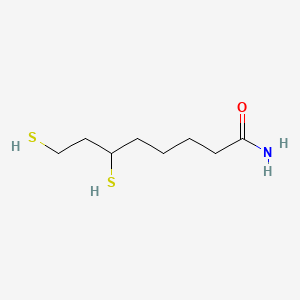| MeSH term | MeSH ID | Detail |
|---|---|---|
| Parkinsonian Disorders | D020734 | 20 associated lipids |
Dihydrolipoamide
Dihydrolipoamide is a lipid of Fatty Acyls (FA) class. Dihydrolipoamide is associated with abnormalities such as Wiskott-Aldrich Syndrome. The involved functions are known as Citric Acid Cycle, Electron Transport, NADH oxidation, Oxidation and Oxidants. Dihydrolipoamide often locates in Mitochondria, Mitochondrial matrix and Chloroplasts. The associated genes with Dihydrolipoamide are Mutant Proteins, Recombinant Proteins, mycothione reductase, Genes, Mitochondrial and alanylproline.
Cross Reference
Introduction
To understand associated biological information of Dihydrolipoamide, we collected biological information of abnormalities, associated pathways, cellular/molecular locations, biological functions, related genes/proteins, lipids and common seen animal/experimental models with organized paragraphs from literatures.
What diseases are associated with Dihydrolipoamide?
Dihydrolipoamide is suspected in and other diseases in descending order of the highest number of associated sentences.
Related references are mostly published in these journals:
| Disease | Cross reference | Weighted score | Related literature |
|---|
Possible diseases from mapped MeSH terms on references
We collected disease MeSH terms mapped to the references associated with Dihydrolipoamide
PubChem Associated disorders and diseases
What pathways are associated with Dihydrolipoamide
There are no associated biomedical information in the current reference collection.
PubChem Biomolecular Interactions and Pathways
Link to PubChem Biomolecular Interactions and PathwaysWhat cellular locations are associated with Dihydrolipoamide?
Visualization in cellular structure
Associated locations are in red color. Not associated locations are in black.
Related references are published most in these journals:
| Location | Cross reference | Weighted score | Related literatures |
|---|
What functions are associated with Dihydrolipoamide?
Related references are published most in these journals:
| Function | Cross reference | Weighted score | Related literatures |
|---|
What lipids are associated with Dihydrolipoamide?
There are no associated biomedical information in the current reference collection.
What genes are associated with Dihydrolipoamide?
Related references are published most in these journals:
| Gene | Cross reference | Weighted score | Related literatures |
|---|
What common seen animal models are associated with Dihydrolipoamide?
There are no associated biomedical information in the current reference collection.
NCBI Entrez Crosslinks
All references with Dihydrolipoamide
Download all related citations| Authors | Title | Published | Journal | PubMed Link |
|---|---|---|---|---|
| Campanucci VA et al. | A novel O2-sensing mechanism in rat glossopharyngeal neurones mediated by a halothane-inhibitable background K+ conductance. | 2003 | J. Physiol. (Lond.) | pmid:12640017 |
| Araújo EJ et al. | Effect of protein and vitamin B deficiency on the morpho-quantitative aspects of the myenteric plexus of the descending colon of adult rats. | 2003 | Arq Neuropsiquiatr | pmid:12806501 |
| Argyrou A et al. | Catalysis of diaphorase reactions by Mycobacterium tuberculosis lipoamide dehydrogenase occurs at the EH4 level. | 2003 | Biochemistry | pmid:12590611 |
| Nordman T et al. | Regeneration of the antioxidant ubiquinol by lipoamide dehydrogenase, thioredoxin reductase and glutathione reductase. | 2003 | Biofactors | pmid:14695919 |
| Shaco-Levy R et al. | On appropriate pathology for photothermal surgery. | 2004 | Lasers Surg Med | pmid:15278925 |
| Starkov AA et al. | Mitochondrial alpha-ketoglutarate dehydrogenase complex generates reactive oxygen species. | 2004 | J. Neurosci. | pmid:15356189 |
| Geisler DA et al. | Antimycin A treatment decreases respiratory internal rotenone-insensitive NADH oxidation capacity in potato leaves. | 2004 | BMC Plant Biol. | pmid:15140267 |
| Rani K et al. | Measurement of bile acid in serum and bile with arylamine-glass-bound 3alpha-hydroxysteroid dehydrogenase and diaphorase. | 2004 | Anal. Biochem. | pmid:15301946 |
| Kozlov G et al. | Structure of GlgS from Escherichia coli suggests a role in protein-protein interactions. | 2004 | BMC Biol. | pmid:15161493 |
| Foster MW and Stamler JS | New insights into protein S-nitrosylation. Mitochondria as a model system. | 2004 | J. Biol. Chem. | pmid:15069080 |
| Klivenyi P et al. | Mice deficient in dihydrolipoamide dehydrogenase show increased vulnerability to MPTP, malonate and 3-nitropropionic acid neurotoxicity. | 2004 | J. Neurochem. | pmid:15009635 |
| Leichert LI and Jakob U | Protein thiol modifications visualized in vivo. | 2004 | PLoS Biol. | pmid:15502869 |
| Argyrou A et al. | Characterization of a new member of the flavoprotein disulfide reductase family of enzymes from Mycobacterium tuberculosis. | 2004 | J. Biol. Chem. | pmid:15456792 |
| Igamberdiev AU et al. | Dihydrolipoamide dehydrogenase from porcine heart catalyzes NADH-dependent scavenging of nitric oxide. | 2004 | FEBS Lett. | pmid:15196936 |
| Rocheleau JV et al. | Quantitative NAD(P)H/flavoprotein autofluorescence imaging reveals metabolic mechanisms of pancreatic islet pyruvate response. | 2004 | J. Biol. Chem. | pmid:15148320 |
| Hiromasa Y et al. | Organization of the cores of the mammalian pyruvate dehydrogenase complex formed by E2 and E2 plus the E3-binding protein and their capacities to bind the E1 and E3 components. | 2004 | J. Biol. Chem. | pmid:14638692 |
| MacDonald MJ et al. | Immunochemical identification of coenzyme Q0-dihydrolipoamide adducts in the E2 components of the alpha-ketoglutarate and pyruvate dehydrogenase complexes partially explains the cellular toxicity of coenzyme Q0. | 2004 | J. Biol. Chem. | pmid:15075342 |
| Mersey BD et al. | Human microRNA (miR29b) expression controls the amount of branched chain alpha-ketoacid dehydrogenase complex in a cell. | 2005 | Hum. Mol. Genet. | pmid:16203741 |
| Sengupta J et al. | Nitric oxide in blastocyst implantation in the rhesus monkey. | 2005 | Reproduction | pmid:16123239 |
| Rajashankar KR et al. | Crystal structure and functional analysis of lipoamide dehydrogenase from Mycobacterium tuberculosis. | 2005 | J. Biol. Chem. | pmid:16093239 |
